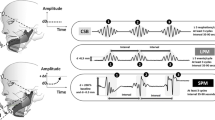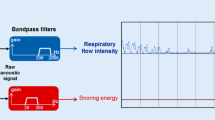Abstract
It is important to identify OSA events accurately for estimating the severity of OSA. Polysomnography examination was complex and not friendly for sleep. This paper proposed a novel method to identify OSA events. Three-channel mandible sEMG and breathing waveform were recorded simultaneously, and FastICA algorithm was applied for decomposing the sEMG signals into three independent components, then to determinate the independent component which has maximum Pearson correlation coefficient with breathing waveform as genioglossus muscle EMG. When the genioglossus muscle EMG value drops to 10% of the maximum value of the individual’s maximum respiratory effort for more than 10 s, it is considered that an OSA event occurs once. Twenty-one OSA patients participated a controlled experiment, which demonstrates that there is no significant difference between the proposed method and Polysomnography examination (P = 0.1726). The proposed method to identify OSA events via mandible sEMG and breathing waveform was proved to be effective non-invasive, and more patient-friendly.






Similar content being viewed by others
References
McSharry, D. G., Saboisky, J. P., Deyoung, P., Matteis, P., Jordan, A. S., Trinder, J., et al. (2013). A mechanism for upper airway stability during slow wave sleep. Sleep, 36(4), 555–563.
Saboisky, J. P., Stashuk, D. W., Hamilton-Wright, A., Trinder, J., Nandedkar, S., & Malhotra, A. (2014). Effects of aging on genioglossus motor units in humans. PLoS ONE, 9(8), e104572.
Nicholas, C. L., Bei, B., Worsnop, C., Malhotra, A., Jordan, A. S., Saboisky, J. P., et al. (2010). Motor unit recruitment in human genioglossus muscle in response to hypercapnia. Sleep, 33(11), 1529–1538.
Wilkinson, V., Malhotra, A., Nicholas, C. L., Worsnop, C., Jordan, A. S., Butler, J. E., et al. (2010). Discharge patterns of human genioglossus motor units during arousal from sleep. Sleep, 33(3), 379–387.
Pittman, L. J., & Bailey, E. F. (2009). Genioglossus and intrinsic electromyographic activities in impeded and unimpeded protrusion tasks. Journal of Neurophysiology, 101(1), 276–282.
Saboisky, J. P., Stashuk, D. W., Hamilton-Wright, A., Carusona, A. L., Campana, L. M., Trinder, J., et al. (2012). Neurogenic changes in the upper airway of patients with obstructive sleep apnea. American Journal of Respiratory and Critical Care Medicine, 185(3), 322–329.
O’Connor, C. M., Lowery, M. M., Doherty, L. S., McHugh, M., O’Muircheartaigh, C., Cullen, J., et al. (2007). Improved surface EMG electrode for measuring genioglossus muscle activity. Respiratory Physiology & Neurobiology, 159(1), 55–67.
Zhao, D., Li, Y., Xian, J., Qu, Y., Zhang, J., Cao, X., et al. (2016). Relationship of genioglossus muscle activation and severity of obstructive sleep apnea and hypopnea syndrome among Chinese patients. Acta Oto-Laryngologica, 136(8), 819–825.
Martins, R. T., Carberry, J. C., & Eckert, D. J. (2016). Breath-to-breath reflex modulation of genioglossus muscle activity in obstructive sleep apnea. Sleep Medicine, 21, 45–46.
Daly, I., Nicolaou, N., Nasuto, S. J., & Warwick, K. (2013). Automated artifact removal from the electroencephalogram: a comparative study. Clinical EEG and Neuroscience, 44(4), 291–306.
von Tscharner, V., Eskofier, B., & Federolf, P. (2011). Removal of the electrocardiogram signal from surface EMG recordings using non-linearly scaled wavelets. Journal of Electromyography and Kinesiology, 21(4), 683–688.
Abtahi, F., Snäll, J., Aslamy, B., Abtahi, S., Seoane, F., & Lindecrantz, K. (2015). Biosignal PI, an affordable open-source ECG and respiration measurement system. Sensors, 15(1), 93–109.
Guo, S., Pang, M., Gao, B., Hirata, H., & Ishihara, H. (2015). Comparison of sEMG-based feature extraction and motion classification methods for upper-limb movement. Sensors, 15(4), 9022–9038.
Shi, J., Cai, Y., Zhu, J., Zhong, J., & Wang, F. (2013). SEMG-based hand motion recognition using cumulative residual entropy and extreme learning machine. Medical & Biological Engineering & Computing, 51(4), 417–427.
Bingham, E., & Hyvarinen, A. (2000). A fast fixed-point algorithm for independent component analysis of complex valued signals. International Journal of Neural Systems, 10(1), 1–8.
Arjunan, S. P., Kumar, D. K., & Naik, G. (2014). Computation and evaluation of features of surface electromyogram to identify the force of muscle contraction and muscle fatigue. BioMed Research International, 2014, 197960.
Song, T., Meng, B., Chen, B., Zhao, D., Cao, Z., Ye, J., et al. (2015). Detection of genioglossus myoelectric activity using ICA of multi-channel mandible sEMG. Technology and Health Care, 23(4), 529.
Acknowledgements
The authors acknowledge the support of Medicine Science Program for Young Scholars of PLA (Grant: 16QNP058) and Presidential Foundation of General Hospital of Jinan Military Command (Grant: 2015GL01).
Author information
Authors and Affiliations
Corresponding author
Rights and permissions
About this article
Cite this article
Song, T., Chen, B., Huang, L. et al. A Novel Method to Identify Obstructive Sleep Apnea Events via Mandible sEMG. Wireless Pers Commun 102, 3677–3686 (2018). https://doi.org/10.1007/s11277-018-5400-7
Published:
Issue Date:
DOI: https://doi.org/10.1007/s11277-018-5400-7




